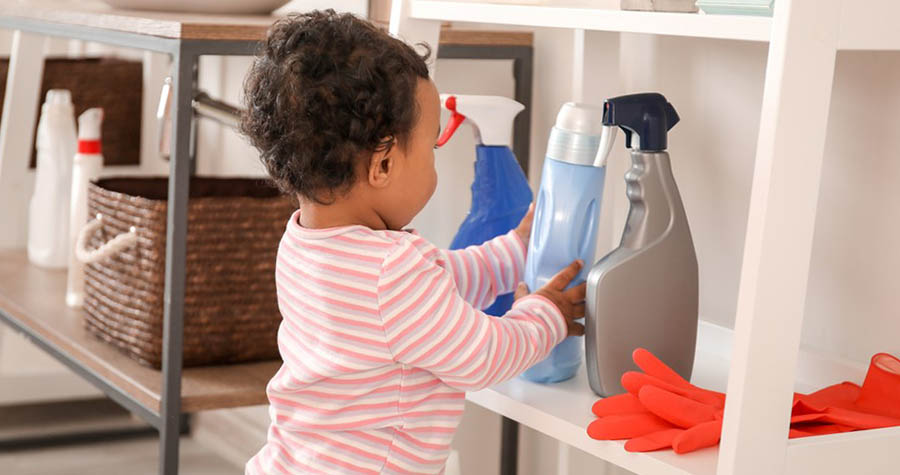
To reduce the risk of accidental poisoning, make sure chemicals, medications and cleaning products are well-labeled and in a safe place.
Accidental poisonings happen when someone ingests harmful chemicals, substances or foods by mistake. This happens most commonly in the home and, if not treated quickly, it can cause adverse health effects. According to the Centers for Disease Control and Prevention (CDC), unintentional poisoning is the leading cause of unintentional injury death in the United States. Learn about the most common type of poisoning and what to do if you or someone else has been exposed to a poisonous substance.
What is the most common type of poisoning?
In 2020, more than 2.1 million poison exposures were reported in the U.S., according to the National Capital Poison Center (NCPC). The majority of those poisonings (76.9%) were unintentional and included children, teens and adults.
The most common substances implicated in poison exposures among children were cosmetics and personal care products, followed by household cleaning substances and pain medications. In adults, opioid overdoses were the most common cause of poisoning, followed by sedatives, sleeping medications and household cleaning supplies. Antidepressants are another common exposure among adults.
The majority of reported poison exposures were nontoxic, minimally toxic or had a minor effect, according to the NCPC. However, more than a third of intentional exposures, such as drug overdoses, caused serious injury or death.
What are the symptoms of poisoning?
Not all poisons cause symptoms right away. Some symptoms can come on slowly or may appear hours after exposure. However, if you think someone has been poisoned, do not wait until the symptoms appear before calling Poison Control.
Symptoms of poisoning can include:
- Confusion
- Slurred speech
- Headache
- Chest pain
- Loss of vision
- Stomach pain, nausea, vomiting or diarrhea
- Very slow or rapid heartbeat/breathing
- Very small or very large pupils
- Difficulty walking or uncoordinated movements
- Loss of bladder or bowel control
Do all poisonings require an emergency room visit?
Some poisoning symptoms can be observed safely at home and do not require a trip to the emergency room. However, if the person who has been exposed has a seizure, becomes unconscious or stops breathing, call 911 immediately.
If the person is still conscious, call Poison Control at (800) 222-1222 or use the online tool at webPoisonControl. The web tool can also help you decide if it is safe to stay home or if a hospital visit is necessary. The web tool is appropriate if the situation meets the following criteria:
- There are no serious symptoms.
- A single substance was involved.
- The poisoning was unintentional.
- The person is between the ages of 6 months and 79 years.
- The person is not pregnant.
- The person is otherwise healthy.
The web tool should not be used if the poisoning was intentional or if there was more than one substance involved. The web tool should not be used for people who are pregnant or for people who are younger than 6 months or over 79 years old.
How to help someone who has been poisoned
If someone has been exposed to an inhaled poison such as carbon monoxide, move the person into fresh air right away. If there is poison on their skin, remove any clothing that the poison has touched and rinse the person's skin with running water for 15 minutes. If the person got poison in their eye, rinse their eye out for 15 to 20 minutes with running water. For swallowed poisons, call Poison Control before administering any treatment.
When you call, make sure to have on hand:
- The medication or poison bottle or container
- The poisoned person's age, weight and any existing health issues, if known
- When and how the poisoning occurred
- Whether or not the person vomited
- What type of first aid you administered, if any
- Where the person is located, and how long it would take to get to the hospital
Treat the symptoms as directed by emergency or Poison Control personnel.
How to prevent accidental poisoning
Accidental poisonings can happen in the blink of an eye. To prevent or reduce the risk of accidental poisoning, be sure to:
- Store medicine, cleaning and laundry products out of reach of children.
- Always follow the instructions on household cleaner product labels, and never mix products together.
- Keep household cleaners and chemicals in their original containers.
- Never share prescription medications, and make sure to check for possible drug interactions if you are taking more than one medication.
- Avoid using bleach on food products.
Poisoning can happen when you least expect it, so it's important to be prepared and know who to contact in the event one does occur. If you are ever unsure about what to do if you suspect someone has been poisoned, you can always call Poison Control. It is free, confidential and accessible 24/7.
$webqFacilityNumber
Need a Physician?